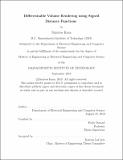| dc.contributor.advisor | Fredo Durand. | en_US |
| dc.contributor.author | Kaza, Srinivas,M. Eng.Massachusetts Institute of Technology. | en_US |
| dc.contributor.other | Massachusetts Institute of Technology. Department of Electrical Engineering and Computer Science. | en_US |
| dc.date.accessioned | 2020-03-24T15:36:32Z | |
| dc.date.available | 2020-03-24T15:36:32Z | |
| dc.date.copyright | 2019 | en_US |
| dc.date.issued | 2019 | en_US |
| dc.identifier.uri | https://hdl.handle.net/1721.1/124253 | |
| dc.description | This electronic version was submitted by the student author. The certified thesis is available in the Institute Archives and Special Collections. | en_US |
| dc.description | Thesis: M. Eng., Massachusetts Institute of Technology, Department of Electrical Engineering and Computer Science, 2019 | en_US |
| dc.description | Cataloged from student-submitted PDF version of thesis. | en_US |
| dc.description | Includes bibliographical references (pages 55-58). | en_US |
| dc.description.abstract | Gradient-based methods are often used in a computer graphics and computer vision context to solve inverse rendering problems. These methods can be used to infer camera parameters, material properties, and even object pose and geometry from 2D images. One of the challenges that faces differentiable rendering systems is handling visibility terms in the rendering equation, which are not continuous on object boundaries. We present a renderer that solves this problem by introducing a form of visibility that is not discontinuous, and thus can be differentiated. This "soft visibility" is inspired by volumetric rendering, and is facilitated by our decision to represent geometry within the scene as a signed distance function. We also present methods for performing gradient descent upon distance fields while preserving Lipschitz continuity. Unlike most differentiable mesh-based renderers, our renderer can optimize between geometry of different homeomorphism classes in a variety of image-based shape fitting tasks. | en_US |
| dc.description.statementofresponsibility | by Srinivas Kaza. | en_US |
| dc.format.extent | 58 pages | en_US |
| dc.language.iso | eng | en_US |
| dc.publisher | Massachusetts Institute of Technology | en_US |
| dc.rights | MIT theses are protected by copyright. They may be viewed, downloaded, or printed from this source but further reproduction or distribution in any format is prohibited without written permission. | en_US |
| dc.rights.uri | http://dspace.mit.edu/handle/1721.1/7582 | en_US |
| dc.subject | Electrical Engineering and Computer Science. | en_US |
| dc.title | Differentiable volume rendering using signed distance functions | en_US |
| dc.type | Thesis | en_US |
| dc.description.degree | M. Eng. | en_US |
| dc.contributor.department | Massachusetts Institute of Technology. Department of Electrical Engineering and Computer Science | en_US |
| dc.identifier.oclc | 1145123039 | en_US |
| dc.description.collection | M.Eng. Massachusetts Institute of Technology, Department of Electrical Engineering and Computer Science | en_US |
| dspace.imported | 2020-03-24T15:36:31Z | en_US |
| mit.thesis.degree | Master | en_US |
| mit.thesis.department | EECS | en_US |
